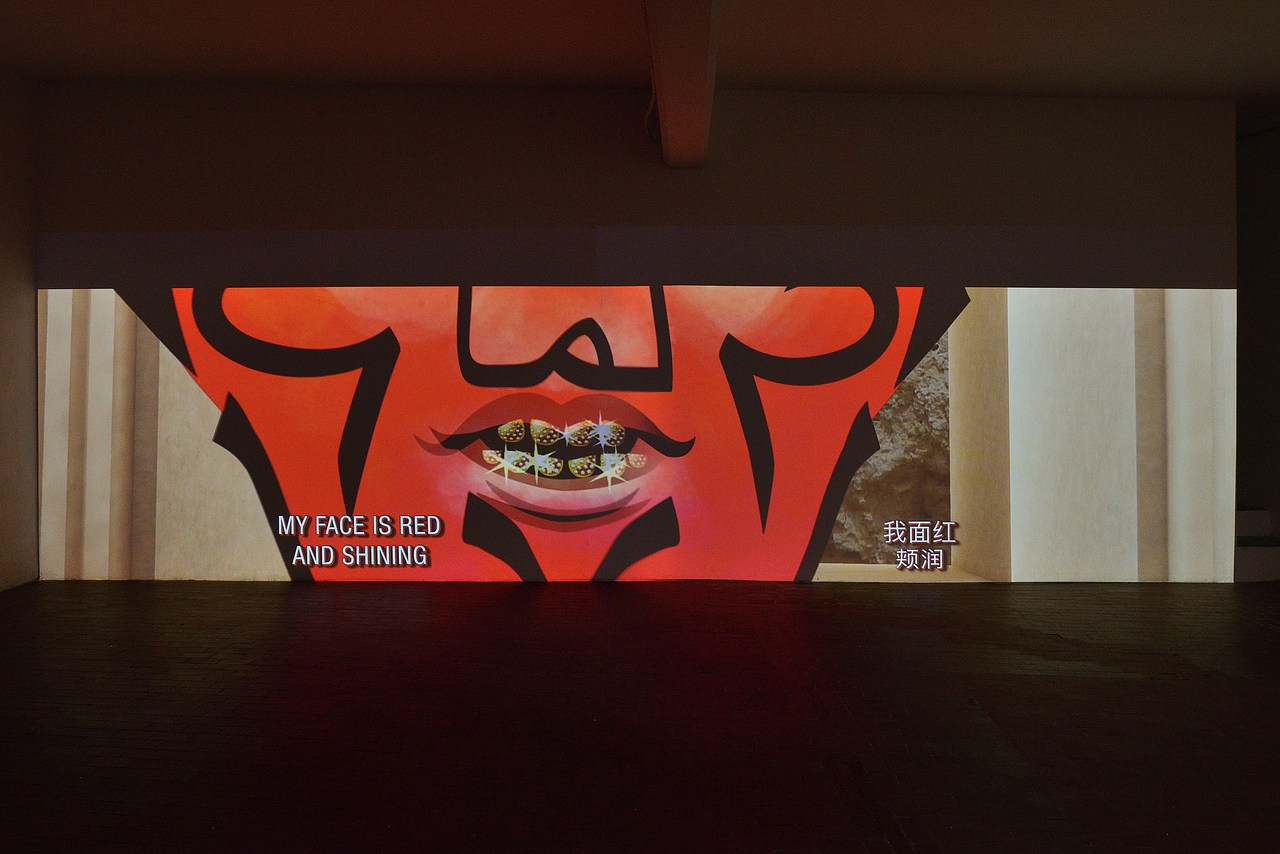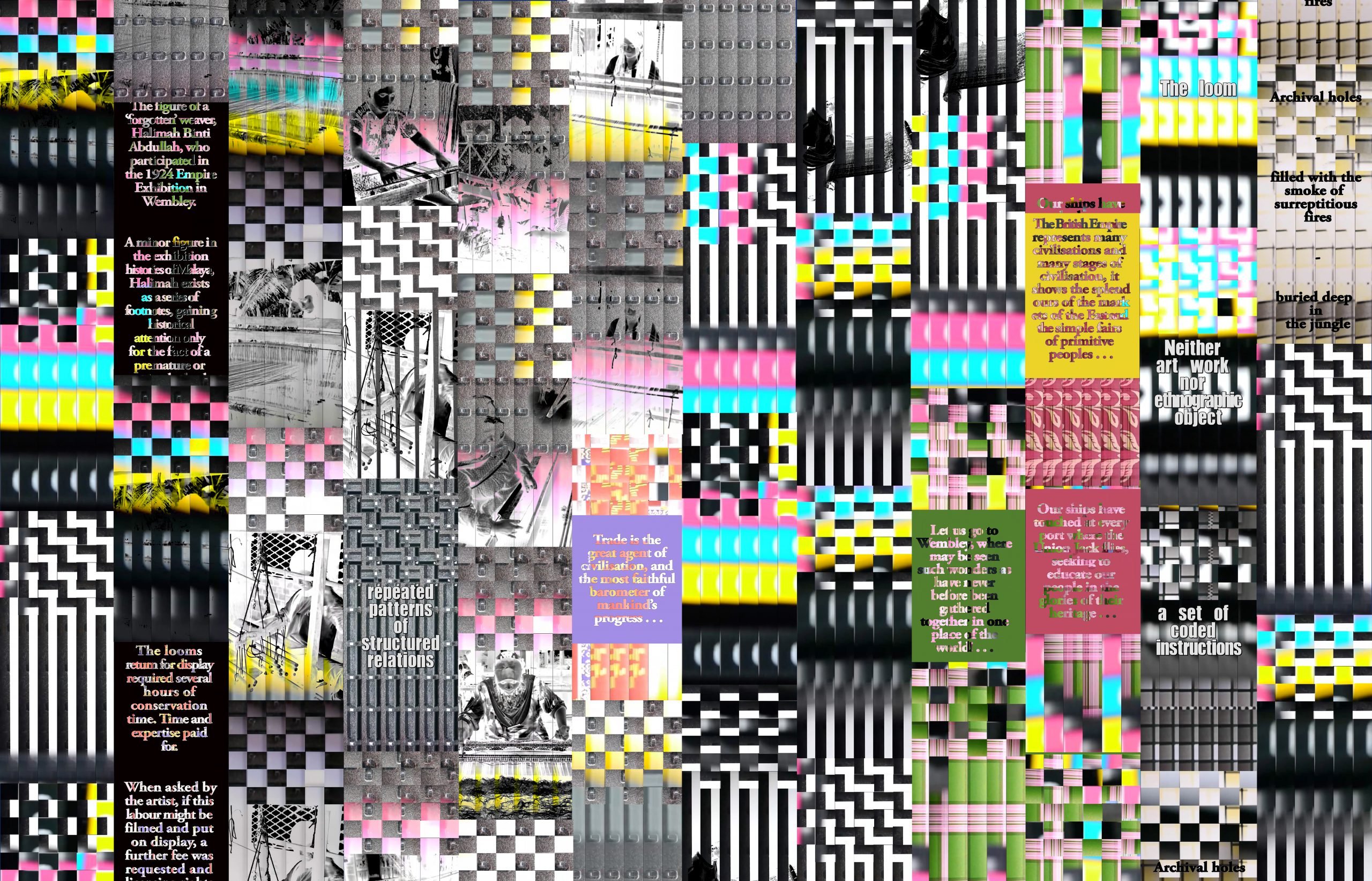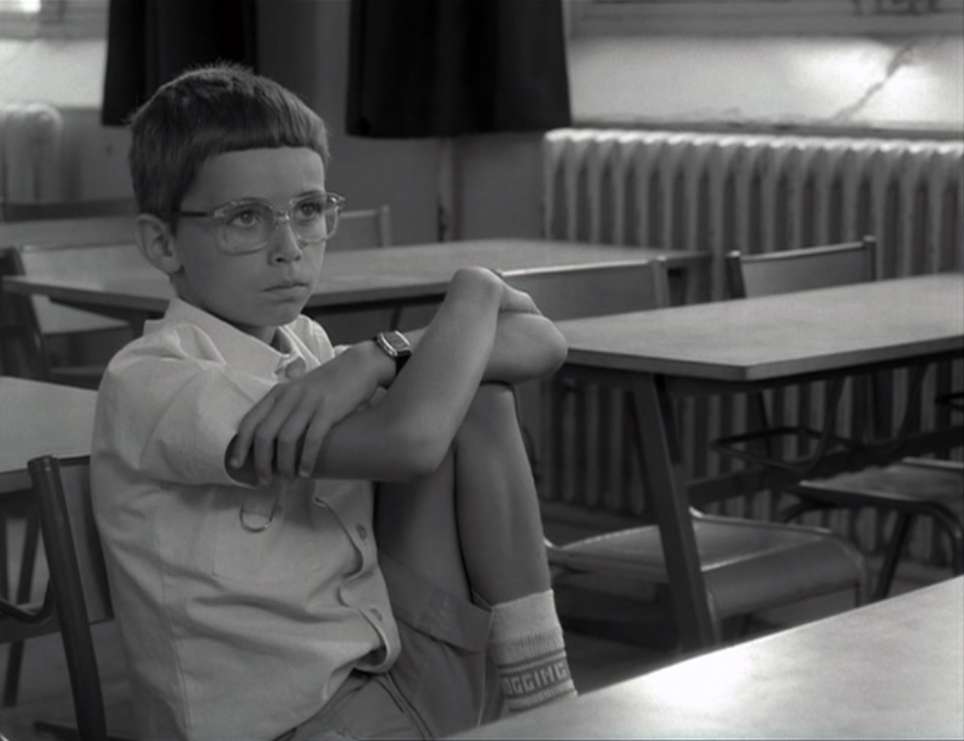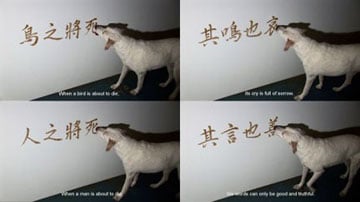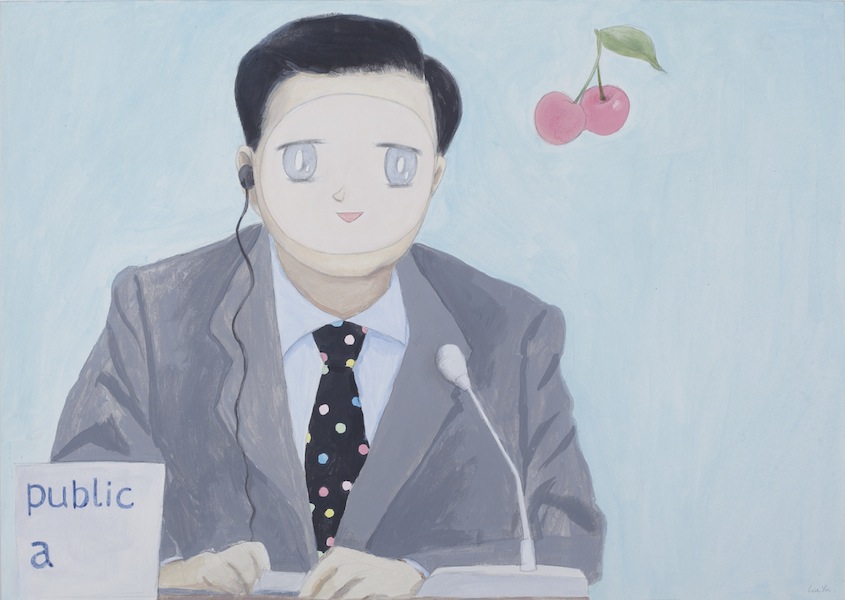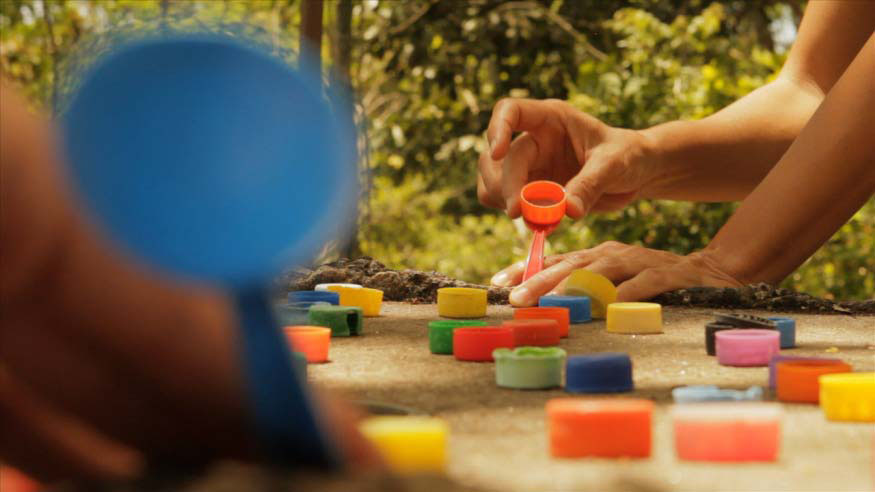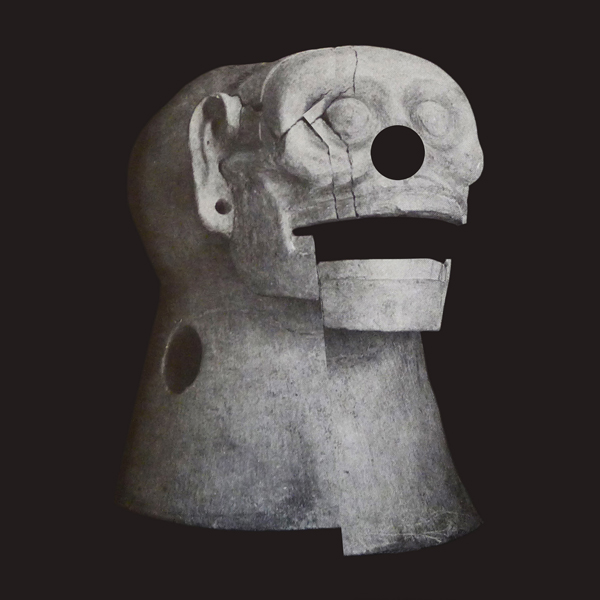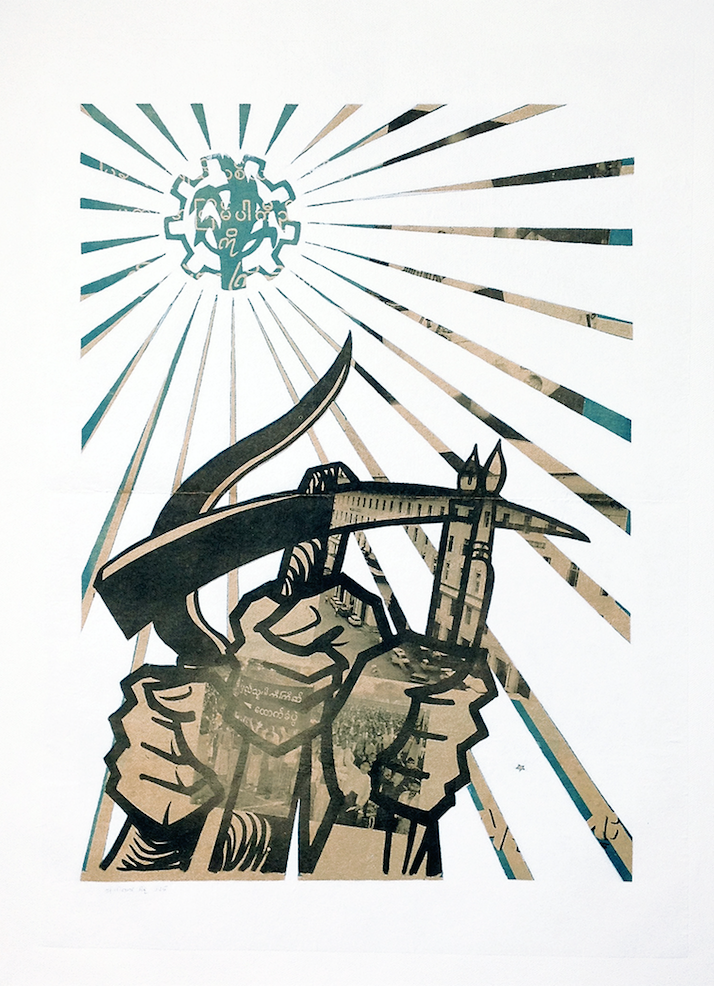
© » KADIST
Tun Win Aung and Wah Nu
Tun Win Aung and Wah Nu initiated the series 1000 Pieces (of White) in 2009, as a way to produce objects and images as a portrait of their shared life as partners and collaborators. Interweaving public and private, personal anecdote and pop cultural appropriation, their work attests to the poetry of the everyday. In addition to found and original materials, the artists have occasionally incorporated drawings and sketches by artist friends, and even by their own daughter into the ongoing work.

© » KADIST
Jane Jin Kaisen and Guston Sondin-Kung
The Woman, The Orphan, and The Tiger begins with the sound of women’s voices describing histories of violence, of things repressed and silenced. Gradually, their voices accumulate into a cacophony of pure sonic intensity against an extreme slow-motioned image of a woman survivor of Japan’s military sexual slavery who, in the absence of words to accurately account for her suffering, gets up and walks into the center of a war crimes tribunal court room and gestures wildly before she faints. This work by Jane Jin Kasen and Guston Sondin-Kung explores ways in which trauma is passed on from previous generations to the present through a sense of being haunted.

© » KADIST
Sin Wai Kin
Drawing & Print (Drawing & Print)
A woman you thought you knew by Sin Wai Kin originates from a performance series titled A View from Elsewhere . Wearing exquisite hair and makeup and a pair of silicone breasts under shimmering diamanté lingerie, Sin Wai Kin’s former persona, Victoria Sin, assumes an alluring, inviting, and intimidating pose. Through subtle and slow movements, this atemporal courtesan appears as a living deity, whose presence embodies codes of representation found in brothels from the turn of the century, burlesque, and Beaux Arts female nude painting.

© » KADIST
Sin Wai Kin
The video Tell me everything you saw, and what you think it means by Sin Wai Kin is from a performance series titled A View from Elsewhere. Wearing exquisite hair and makeup and a pair of silicone breasts under shimmering diamanté lingerie, Sin Wai Kin’s former persona, Victoria Sin, assumes an alluring, inviting, and intimidating pose. Through subtle and slow movements, this atemporal courtesan appears as a living deity, whose presence embodies codes of representation found in brothels from the turn of the century, burlesque, and Beaux Arts female nude painting.
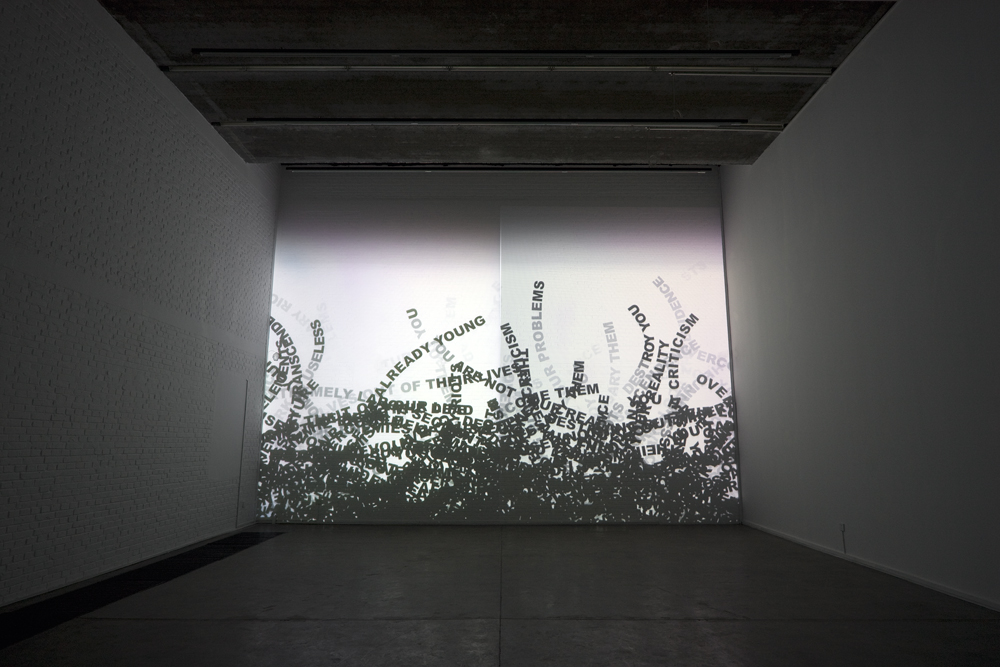
© » KADIST
Tsang Kin-Wah
The Third Seal—They Are Already Old. They Don’t Need To Exist Anymore is part of The Seven Seals , Tsang’s ongoing series of digital videos that are projected as installations onto the walls and ceilings of dark rooms. Using texts and computer technology, the series draws its reference from various sources—the Bible, Judeo-Christian eschatology, existentialism, metaphysics, politics, among others—to articulate the world’s complexity and the dilemmas that people face while approaching “the end of the world.” The Third Seal is a nineteen-by-twenty-seven-foot projection on a single wall that, together with sound, creates an immersive and dynamic environment.

© » KADIST
siren eun young jung
Drawing & Print (Drawing & Print)
Deferral Archive is one of the archival extensions of siren eun young jung’s Yeoseong Gukgeuk Project (2008-), a decade-long ethnographic research project into the diminishing genre of Korean traditional theater known as Yeoseong Gukgeuk . The genre, which was popular in the 1950s-60s, has since been forgotten, without ever being established as either a traditional or modern form of Korean theater. The most distinctive formal trait of Yeoseong Gukgeuk is that the theater performers are exclusively women.

© » KADIST
siren eun young jung
Deferral Archive is one of the archival extensions of siren eun young jung’s Yeoseong Gukgeuk Project (2008-), a decade-long ethnographic research project into the diminishing genre of Korean traditional theater known as Yeoseong Gukgeuk . The genre, which was popular in the 1950s-60s, has since been forgotten, without ever being established as either a traditional or modern form of Korean theater. The most distinctive formal trait of Yeoseong Gukgeuk is that the theater performers are exclusively women.

© » KADIST
siren eun young jung
Taking the same name as their most recent solo show at the Kunstverein für die Rheinlande und Westfalen in Düsseldorf, siren eun young jung’s video work Deferral Theatre intertwines various threads from the last decade of the artist’s research into the Yeoseong Gukgeuk theatrical form, in which all of the roles are played by women, as well as performance-based modes of queer resistance in South Korea. The radical and temporally border-crossing qualities of gender fluidity, and lineages of queer subversion within performative spaces, animate Deferral Theatre through a critical deconstruction of Korean history, tradition and gender norms. One particularly powerful scene depicts a young drag king performer tearing at their suit and tie as they lip-sync passionately to a song in English, while the frame lilts with an ecstatic languor, as if the operator of the camera were staggering feverishly.

© » KADIST
siren eun young jung
Deferral Archive is one of the archival extensions of siren eun young jung’s Yeoseong Gukgeuk Project (2008-), a decade-long ethnographic research project into the diminishing genre of Korean traditional theater known as Yeoseong Gukgeuk . The genre, which was popular in the 1950s-60s, has since been forgotten, without ever being established as either a traditional or modern form of Korean theater. The most distinctive formal trait of Yeoseong Gukgeuk is that the theater performers are exclusively women.

© » KADIST
siren eun young jung
Lyrics 1, 2, 3 is part of siren eun young jung Yeoseong Gukgeuk Project (2008–). The work closely follows first and second generations of Yeoseong Gukgeuk actresses, who later became an important source of inspiration for the artist. Formally, this genre of theater draws from Westernized aspects of traditional Korean music performance, as well as from adaptations of pansori , a Korean genre of musical storytelling, to create a staged version of traditional Korean opera.

© » KADIST
Lam Tung Pang
Drawing & Print (Drawing & Print)
Lam Tung Pang created Sketches from train ride Chicago to San Francisco during his travels through the United States researching American curatorial strategies for representing traditional Chinese painting in museums and cultural institutions. The drawings incorporate both traditional and contemporary Chinese landscape techniques to reflect on the memory, history, and aesthetic practices of the Chinese laborers who played a prominent role in the American westward expansion. By representing the Western landscape according to Chinese aesthetics, Lam calls attention to the distortions and cultural specificity of American representations of the Western landscape and non-Western cultures.

© » KADIST
Truong Cong Tung
Truong Cong Tung’s Journey of a Piece of Soil (2013) and its accompanying object-based installation of the same name (2014) consider the function of ritual in larger modes of collective engagement and cultural production. In examining how spirituality inflects social engagement, Truong’s contemplates the juncture at which the rational beings encounter the unexplained while also suggesting how embodied practices offer vital conduits for experiencing new modes of consciousness. The video features a man dressed in camouflage fatigues with a blue cap tilling a patch of red-clay soil amidst a green-stalk covered patch of land.

© » KADIST
siren eun young jung
Drawing & Print (Drawing & Print)
Deferral Archive is one of the archival extensions of siren eun young jung’s Yeoseong Gukgeuk Project (2008-), a decade-long ethnographic research project into the diminishing genre of Korean traditional theater known as Yeoseong Gukgeuk . The genre, which was popular in the 1950s-60s, has since been forgotten, without ever being established as either a traditional or modern form of Korean theater. The most distinctive formal trait of Yeoseong Gukgeuk is that the theater performers are exclusively women.

© » KADIST
Wong Wai Yin
Drawn from the widely circulated images of protests around the world in support of women rights and racial equality, the phrase I can’t believe we are still protesting is both the title of Wong Wai Yin’s photographic series and a reference to similar messages seen on protest signages. The artist used found images from the internet, including a viral photo of an elderly woman who took part in the 2016 “Black Monday” strike against a proposed anti-abortion law in Poland, and another image taken the same year of a group of protestors in the United Kingdom, rallying for the Black Lives Matter movement. Drawing parallels with Hank Willis Thomas’s I Am a Man (2013) painting in the KADIST Collection, Wong employs the visual language and terminology of mass media, specifically borrowing images from protests on civil rights issues.

© » KADIST
Wong Wai Yin
In this work the artist stages a humorously violent “intervention” against male-dominated cultures of art production in present-day China. For this video, Wong accompanied six male friends from art school to a group show of their work titled “Inside Looking Out” at Osage Gallery in Beijing. Throughout her visit, she was rarely acknowledged for her own creative accomplishments and was more frequently introduced as an artist’s girlfriend, and often without name.

© » KADIST
Wong Wai Yin
Drawn from the widely circulated images of protests around the world in support of women rights and racial equality, the phrase I can’t believe we are still protesting is both the title of Wong Wai Yin’s photographic series and a reference to similar messages seen on protest signages. The artist used found images from the internet, including a viral photo of an elderly woman who took part in the 2016 “Black Monday” strike against a proposed anti-abortion law in Poland, and another image taken the same year of a group of protestors in the United Kingdom, rallying for the Black Lives Matter movement. Drawing parallels with Hank Willis Thomas’s I Am a Man (2013) painting in the KADIST Collection, Wong employs the visual language and terminology of mass media, specifically borrowing images from protests on civil rights issues.

© » KADIST
Wong Wai Yin
Drawn from the widely circulated images of protests around the world in support of women rights and racial equality, the phrase I can’t believe we are still protesting is both the title of Wong Wai Yin’s photographic series and a reference to similar messages seen on protest signages. The artist used found images from the internet, including a viral photo of an elderly woman who took part in the 2016 “Black Monday” strike against a proposed anti-abortion law in Poland, and another image taken the same year of a group of protestors in the United Kingdom, rallying for the Black Lives Matter movement. Drawing parallels with Hank Willis Thomas’s I Am a Man (2013) painting in the KADIST Collection, Wong employs the visual language and terminology of mass media, specifically borrowing images from protests on civil rights issues.

© » KADIST
Wong Wai Yin
Drawn from the widely circulated images of protests around the world in support of women rights and racial equality, the phrase I can’t believe we are still protesting is both the title of Wong Wai Yin’s photographic series and a reference to similar messages seen on protest signages. The artist used found images from the internet, including a viral photo of an elderly woman who took part in the 2016 “Black Monday” strike against a proposed anti-abortion law in Poland, and another image taken the same year of a group of protestors in the United Kingdom, rallying for the Black Lives Matter movement. Drawing parallels with Hank Willis Thomas’s I Am a Man (2013) painting in the KADIST Collection, Wong employs the visual language and terminology of mass media, specifically borrowing images from protests on civil rights issues.

© » KADIST
Christine Sun Kim and Thomas Mader
Indexes that either allow or inhibit the establishment of communication exist in both signed as well as spoken languages. Some differ radically depending on a variety of social, economic and geographical factors, while others are universally understood. Seemingly small and fleeting gestures can determine a sense of affiliation or a feeling of rejection.

© » KADIST
Sun Xun
Sun Xun’s lushly illustrated, dynamic short film Mythological Time is a dreamy chronicle of rapacious industrial development, the mythical qualities of state propaganda, and the constancy of change, as experienced by an unnamed coal mining town. While it is not named in the film itself, the town at the center of Mythological Time is a re-imagined incarnation of Sun’s hometown of Fuxin, in the northern Chinese province of Liaoning. Sandwiched between North Korea and Inner Mongolia, Fuxin is a poor coal-mining region that used to contain one of China’s largest open-pit mines and has historically been the site of significant conflict, thanks to its rich mineral resources.

© » KADIST
Sun Xun
Sun’s animated film 21 Ke (21 Grams) is based on the 1907 research by the American physician Dr. Duncan MacDougall who claimed the measured weight of the human soul to be twenty-one grams. Sun used this episode—which was not fully recognized by the scientific community—as a point of departure for his depiction of a dystopian world in which the narration of history and notion of time are interrupted. Because each frame was drawn by hand with crayon, it took Sun and his animation studio team a few years to complete this thirty-minute film of a surreal journey through mysterious cities, plagues of mosquitoes, broken statues, cawing ravens, waving flags, and flooded graveyards.

© » KADIST
Aung Ko
They burn our village by Aung Ko is part of the artist’s daily visual diary as an attempt to process and note what has been happening in Myanmar while he is being exiled, following the military takeover of the government in February 2021. Almost two years ago, Myanmar’s military ousted the democratically elected government of Aung San Suu Kyi and seized power in a coup. Since then, the country has descended into turmoil.

© » KADIST
Yung Jake
Unfollow is a music video by Yung Jake featuring a man haunted by the shadows of a former relationship. With the omnipresence of social media in our daily lives, breaking up in the physical world no longer suffices: posts by his ex-lover still appear in his newsfeed, reminding him of her presence and thus making it harder from him to let go of his relationship. As the ‘unfollow’ button on social media appears to be the only way to break up completely, Unfollow underlines the barrier between our online and offline identities and the difficulty to separate them.

© » KADIST
Sung Tieu
Modelled and rendered in 3D, Moving Target Shadow Detection by Sung Tieu reconstructs the entire interior of the Hotel Nacional de Cuba in Havana, the site of the first-known instance of a supposed sonic attack, which collectively became known as ‘Havana Syndrome’. First reported by CIA staff in the Cuban capital in 2016, the syndrome includes a range of unexplained disorders ranging from nausea, fatigue and memory loss to brain injuries resembling concussions. In Tieu’s film, CCTV camera footage and images taken by a nano drone lead from the hotel’s lobby to an occupied hotel room, where the viewer is confronted with classified documents and news reportages of the recent Havana Syndrome attacks around the world.

© » KADIST
Yung Jake
I don’t remember is a video by Yung Jake that combines his passion for both music and the visual arts. As per several of his works the video borrows from the vernacular of rap and relies on the aesthetic and stylistic qualities of music videos. A humorous interpretation of the rap and hip hop genres, the video combines scenes from urban settings and snapshots of a party as the artist raps in a drowsy monotone about having forgotten the wild night.

© » KADIST
Yung Jake
As the video Datamosh begins to play, Yung Jake emerges out of a colorful, smoke-like background and breaks into rap. Malfunctioning green screens and pixelated digital mash-ups bleed into each other in a parody of the music video trope and specifically of the trend of ‘datamoshing’—a digital technique commonly used across this genre. The song’s lyrics distinctly borrow from the lexicon of rap, combining mentions of clubs, money and fame, with self-referential and humorous lines that literally describe the way in which the artist subverts the medium.

© » KADIST
Sarah Lai Cheuk Wah
Back images is a series of six photographs by Sarah Lei Cheuk Wah that explore the semiotics of power and their intersection with representations of masculinity. The photographs feature what seem to be stock images of several policemen—their rugged uniforms, vehicles and weapons drenching the photographs with signs of masculinity and power as the policemen carry on with their usual tasks. The series was part of a larger exhibition entitled In Stasis where Lei transformed the booth of an art fair into what appeared to be a security area inside an airport.

© » KADIST
Erika Tan
APA JIKA, The Mis-Placed Comma is one of three works Erika Tan filmed within exhibition spaces during the final stages of their transition from colonial period law courts to the National Gallery Singapore. Part of an on-going body of work, this video focuses on the figure of a forgotten weaver, Halimah Binti Abdullah, who participated in the 1924 British Empire Exhibition in the United Kingdom. A minor figure in the exhibition histories of what was formerly known as Malaya (today, Singapore and Malaysia), Halimah exists as a series of footnotes, gaining historical attention only for the act of a premature death from pneumonia, in London and away from home.

© » KADIST
Wang Tuo
Wailing Requiem is the fourth and final chapter of The Northeast Tetralogy , a film project that Wang Tuo began in 2017. The project is a unique regional research of Northeastern China that addresses the region’s geopolitical contentions. Drawing on significant moments from China’s modern history, Wang’s visual storytelling sets up and displaces a series of socio-historical situations through multiple narrative structures.

© » KADIST
Xu Tan
Drawing & Print (Drawing & Print)
Shanghai Biennale, Awaiting Your Arrival is an appropriation of the posters made to promote biennial art exhibitions. Displayed alongside the marketing posters of official biennials (Shanghai, Berlin, Venice, etc.) Displayed alongside the official marketing materials of biennials (Shanghai, Berlin, Venice, etc.)
siren eun young jung
With a practice deeply engaged with feminism and LGBT rights issues, siren eun young jung reveals the subversive power of traditional culture, one unknown in the Korean modernization period, and provides unique perspectives and documentation of important communities...
Wang Tuo
Through film, performance, painting, and drawing, artist Wang Tuo interweaves disparate realities through archives, modern history, myth, and literature...
Wong Wai Yin
Wong Wai Yin is an interdisciplinary artist who experiments with a variety of media ranging from painting, sculpture, collage, performance, video, installations and photography...
Yin-Ju Chen
- year born: 2011
- gender: female
- nationality: American & Taiwanese
Sung Hwan Kim
In his practice, Sung Hwan Kim assumes the role of director, editor, performer, composer, narrator, and poet...
Lin Yilin
- location: Beijing & New York
- year born: 1964
- gender: male
- nationality: Chinese
- home town: Guangzhou, China
Yung Jake
Yung Jake is a visual artist and YouTube rapper based in Los Angeles whose work fuses new media, music, and art...
Chantal Edie and Zacharie Ngnogue
Chantal Edie and Zacharie Ngnogue are a photography duo who channel their personal experiences into social commentaries...
Cerith Wyn Evans
- location: London, United Kingdom
- year born: 1958
- gender: male
- nationality: British
- home town: Llanelli, United Kingdom
Ad Minoliti
Ad Minoliti is a painter who combines the pictorial language of geometric abstraction with the perspective of queer theory...
Ana Vaz
Ana Vaz is an artist and filmmaker whose works speculate on the relationships between self and other, and myth and history, through a cosmology of signs, references, and perspectives...
Christine Sun Kim
- location: New York, New York
- year born: 1980
- gender: female
- nationality: American
- home town: Orange County, California
Leung Chi Wo and Wong Sara
Leung Chi Wo tends to highlight in his art the boundaries between viewing and voyeurism, real and fictional, and art and the everyday...
Mary Ann Aitken
Mary Ann Aitken was known to be very private about her art practice; she was considered somewhat of an outsider by her peers affiliated with the second wave of Detroit’s Cass Corridor arts movement...
Ho Rui An
The artist, writer, and researcher Ho Rui An probes histories of globalization and governance, performing a detournement of dominant semiotic systems across text, film, installation, and lecture...
Young Min Moon
Young Min Moon is a Korean American artist, curator, critic, and art historian, who migrated to the United States from South Korea as a teenager...
Xu Tan
- location: Amsterdam, Netherlands
- year born: 1966
- gender: female
- nationality: Dutch
- home town: Pekan Baru, Indonesia
An-My LE
- location: New York, New York
- year born: 1960
- gender: female
- home town: Saigon, Vietnam
Lin Ke
Lin Ke’s video and media-based installations explore how perceptual experiences of our surrounding environments are mediated and altered by various technologies...
Erika Tan
Erika Tan’s practice is primarily research-driven with a focus on the moving image, referencing distributed media in the form of cinema, gallery-based works, Internet and digital practices...
John Wood and Paul Harrison
John Wood and Paul Harrison have been working collaboratively since 1993, producing single screen and installation-based video works...
Sun Xun
- location: Hangzhou, China
- year born: 1980
- gender: male
- nationality: Chinese
- home town: Fuxin, Liaoning Provence, China
Sin Wai Kin
Through performance, moving image, writing, and print, artist Sin Wai Kin (formerly known as Victoria Sin) uses speculative fiction to interrupt normative processes of desire, identification, and objectification...
Tan Zi Hao
Tan Zi Hao is a multi-disciplinary artist who works predominantly with installation and performance art...
Tuan Andrew Nguyen
Tuan Andrew Nguyen is an artist and filmmaker, one of the three founders of The Propeller Group created in 2006...
Michelle and Noel Keserwany
Michelle and Noël Keserwany compose and perform their own songs, as well as contribute to the illustrations and animations featured in the videos they produced...
Ei Arakawa and Sergei Tcherepnin
Ei Arakawa and Sergei Tcherepnin began their audio-visual and performative collaboration in 2007...

© » APERTURE
about 4 months ago (12/01/2023)
For the past two decades, An-My Lê has used photography to examine her personal history and the legacies of US military power, probing the tension between experience and storytelling....
-
1980-1989
Jean-Marie Straub and Danièle Huillet
1982En rachâchant is based on the short story Ah! Ernesto! (1971) by Marguerite Duras in which the child Ernesto does not want to go to school anymore as all that he is taught are things he does not know...
-
1990-1999
John Wood and Paul Harrison
1996One of John Wood and Paul Harrison’s earliest works, Device features Harrison performing a series of actions, assisted by the titular ‘devices’, that use physics to force his body into unusual and uncomfortable positions...
John Wood and Paul Harrison
19973-Legged is an early video work by John Wood and Paul Harrison in which they appear with their legs tied together (as one would do in a three-legged race)...
-
2000-2009
Xu Tan
Drawing & Print
2000(Drawing & Print) Shanghai Biennale, Awaiting Your Arrival is an appropriation of the posters made to promote biennial art exhibitions...
Mary Ann Aitken
2002Untitled (Boom Box, Double-Sided) by Mary Ann Aitken is representational painting of a boom box on an unconventionally long canvas painted on both sides, to mimic the scale and appearance of the actual appliance...
Xu Tan
Drawing & Print
2003(Drawing & Print) Biennale, Dog is an appropriation of the posters made to promote biennial art exhibitions...
Jun Nguyen-Hatsushiba
2003Filmed underwater, this is the third video in Nguyen-Hatsushiba’s “Memorial Project” series which began in 2001...
Maayan Amir and Ruti Sela
2003In Beyond Guilt the two artists create a portrait of our generation in three parts...
Sung Hwan Kim
2007An early work in Sung Hwang Kim’s career, the video Summer Days in Keijo—written in 1937 is a fictional documentary, the film is based on a non-fiction travelogue, In Korean Wilds and Villages , written by Swedish zoologist Sten Bergman, who lived in Korea from 1935 to 1937...
Sung Hwan Kim
Drawing & Print
2007(Drawing & Print) Sung Hwan Kim created the drawing push against the air 01 during a rehearsal for his eponymous 2007 performance at De Apple (as part of Prix de Rome), Amsterdam, and Project Arts Centre, Dublin...
Wong Wai Yin
2008In this work the artist stages a humorously violent “intervention” against male-dominated cultures of art production in present-day China...
Hung-Chin Peng
2008In Excerpts from the Analects of Confucius , Peng Hung-Chih explores the relationship between Confucianism and religion...
Nguyen Thai Tuan
2008In the “Black Paintings” series, although the human body is only suggested, it plays an important role...
Cerith Wyn Evans
2008Untitled (Perfect Lovers + 1) by Cerith Wyn Evans takes as its starting point Felix Gonzales-Torres’s seminal work Untitled (Perfect Lovers) , in which two clocks were synchronized and left to run without interference, the implication being that one would stop before the other...
Pauline Boudry and Renate Lorenz
2009Salomania sees choreographer and filmmaker Yvonne Rainer and artist Wu Tsang rehearse scenes from Valda’s Solo , a chapter of a film Rainer made in 1972 after having seen women perform the dance of the seven veils in Alla Nazimova’s 1923 silent film Salomé ...
Jay Chung and Takeki Maeda
2009Jay Chung and Q Takeki Maeda remake a clip from the 1970s they found on the internet, and without really changing this archive material, displace it by imitating the staging and the acting with scrupulous precision...
Mary Ann Aitken
2009Untitled (Diptych) by Mary Ann Aitken is a pair of paintings; one entirely abstract and the other a hybrid of representational and abstract elements...
-
2010-2019
Jane Jin Kaisen and Guston Sondin-Kung
2010The Woman, The Orphan, and The Tiger begins with the sound of women’s voices describing histories of violence, of things repressed and silenced...
Sung Hwan Kim
Drawing & Print
2010(Drawing & Print) This untitled drawing was part of Sung Hwan Kim’s solo exhibition Sung Hwan Kim: A Still Window From Two or More Places , which took place in tranzitdisplay in Prague, Czech Republic in 2010...
Sung Hwan Kim
Drawing & Print
2010(Drawing & Print) This untitled drawing was part of Sung Hwan Kim’s solo exhibition Sung Hwan Kim: A Still Window From Two or More Places , which took place in tranzitdisplay in Prague, Czech Republic in 2010...
Olive Martin and Patrick Bernier
2010The Mohawk, the emblematic Frontier river in the period of American colonisation, is here a cable of data transmission, and the 7 Sultans Casino is a virtual destination, one of the three hundred online casinos hosted by the servers located in Kahnawake, a small native american indian reserve to the south of Montreal...
The Propeller Group and Superflex
2010Fade In (the whole title of the film is actually the entire five page script) is a collaboration with the Danish artist collective Superflex (group of freelance artist–designer–activists committed to social and economic change, founded in 1993 by Jakob Fenger, Rasmus Nielsen and Bjørnstjerne Christiansen)...
Leung Chi Wo and Wong Sara
2010Office Lady with a Red Umbrella restages a figure from a 1980 postcard made from a photograph from 1950’s...
Leung Chi Wo and Wong Sara
2010Photojournalist with Two Cameras restages a portrait of a photojournalist from the background of an old photograph of protest published in South China Morning Post on January 10, 2010 under the headline “Return of the Radicals: Recent angry protests are nothing new.” The photojournalist in the photograph, probably from a protest of earlier decades, was capturing the scene of a protester’s arrest while wearing two cameras...
An-My LE
2010The print Patient Admission, US Naval Hospital Ship Mercy, Vietnam (2010) features an Asian Buddhist monk and an American Navy Solider on board the Mercy ship –one of the two dedicated hospital ships of the United States Navy– sitting upright in their chairs and adopting the same posture...
Võ An Khánh
2010In Extra Curriculum Political Science Class 7/1972 , a group of women walk bare-foot and single file towards Dat Mui Mangrove in Ca Mau Province to attend ‘political science class’...
Tun Win Aung and Wah Nu
2011Tun Win Aung and Wah Nu initiated the series 1000 Pieces (of White) in 2009, as a way to produce objects and images as a portrait of their shared life as partners and collaborators...
Yin-Ju Chen
Drawing & Print
2011(Drawing & Print) This work includes sketches for Extrastellar Evaluations , the project she produced at Kadist...
Ei Arakawa and Sergei Tcherepnin
2011Part of a series entitled “Looking at Listening”, 2011, the piece invited the spectator to experiment and consider sound as a kinetic and synesthetic process, where multiple experiences and senses can cross...
Ana Teresa Fernández
Drawing & Print
2011(Drawing & Print) The artist writes about her work Borrando la Frontera, a performance done at Tijuana/San Diego border: “I visually erased the train rails that serve as a divider between the US and Mexico...
Tuan Andrew Nguyen
2012This work presents the image of an immolated monk engraved on a baseball bat...
Donna Conlon and Jonathan Harker
2012In Tapitapultas (2012), Donna Conlon and Jonathan Harker comment on mass consumerism and pollution by way of a game they invented...
Ana Roldán
2012Ana Roldán’s Primeval forms series looks up close at the fecund shapes of plants often found in the artist’s native Mexico...
Ana Roldán
2012Ana Roldán’s Displacements works use images taken from a 1970s exhibition catalogue for an exhibition called The Death in Mexico...
siren eun young jung
2013Deferral Archive is one of the archival extensions of siren eun young jung’s Yeoseong Gukgeuk Project (2008-), a decade-long ethnographic research project into the diminishing genre of Korean traditional theater known as Yeoseong Gukgeuk ...
siren eun young jung
2013Lyrics 1, 2, 3 is part of siren eun young jung Yeoseong Gukgeuk Project (2008–)...
Lam Tung Pang
Drawing & Print
2013(Drawing & Print) Lam Tung Pang created Sketches from train ride Chicago to San Francisco during his travels through the United States researching American curatorial strategies for representing traditional Chinese painting in museums and cultural institutions...
Lin Ke
Drawing & Print
2013(Drawing & Print) Jet Folder & Data Tree (2013) offers a humorous take on how computer and screen-based technologies affect our relationship to the natural world...
Tan Zi Hao
2013Tan Zi Hao produced Pest Control 1110, 709, 428 (or, a Myth for Another) , in response to the Bersih social movement, that catalyzed three rallies on 10th November 2007, 9th July 2011 and 28th April 2012, respectively, to demand a clean electoral roll...
Chris Huen Sin-Kan
2013Contrast to the bustling and unrelenting experience of a city such as Hong Kong, Chris Huen Sin Kan paints the tranquil interiors of his apartment, where he leads a modest and almost hermit-like life...
TU Pei-Shih
2013Making Fantasies animates scenes based upon photographs by Nan Goldin, Larry Sultan, Richard Billingham, Yasuyoshi Chiba and famous photojournalism images such as Jeff Widener’s photograph of Tiananmen Square and Kevin Carter’s photograph of a Sudanese child being stalked by a vulture...
siren eun young jung
Drawing & Print
2015(Drawing & Print) Deferral Archive is one of the archival extensions of siren eun young jung’s Yeoseong Gukgeuk Project (2008-), a decade-long ethnographic research project into the diminishing genre of Korean traditional theater known as Yeoseong Gukgeuk ...
siren eun young jung
2015Deferral Archive is one of the archival extensions of siren eun young jung’s Yeoseong Gukgeuk Project (2008-), a decade-long ethnographic research project into the diminishing genre of Korean traditional theater known as Yeoseong Gukgeuk ...
Sarah Lai Cheuk Wah
2015Back images is a series of six photographs by Sarah Lei Cheuk Wah that explore the semiotics of power and their intersection with representations of masculinity...
Candice Lin
2015For the work Wigan Pit-Brow Women: Intersections with the Caribbean (mobile) , Candice Lin studied English Victorian Arthur Munby’s racialized and masculinized drawings of working-class white female miners...
Gabriella and Silvana Mangano
2015There is no there by Gabriella and Silvana Mangano is a black and white looped video with sound, in conjunction with a live performance...
João Maria Gusmão and Pedro Paiva
2015The artist duo João Maria Gusmão and Pedro Paiva traveled to Japan for a month to make a series of short 16mm films, often shot in slow-motion...
Christine Sun Kim and Thomas Mader
2016Indexes that either allow or inhibit the establishment of communication exist in both signed as well as spoken languages...
Yin-Ju Chen
2016Through a semi-fictional approach, Extrastellar Evaluations envisions a version of history in which alien inhabitants, the Lemurians, lived among humans under the guise of various renowned conceptual and minimal artists in the 1960s (Carl Andre, Mel Bochner, and James Turrell to name a few)...
Sin Wai Kin
Drawing & Print
2017(Drawing & Print) A woman you thought you knew by Sin Wai Kin originates from a performance series titled A View from Elsewhere ...
Etel Adnan and Lynn Marie Kirby
Drawing & Print
2017(Drawing & Print) In conjunction with KADIST’s 2017 exhibition If Not Apollo, the Breeze , artist and filmmaker Lynn Marie Kirby performed Transmissions , a video and live reading created with longtime collaborator Etel Adnan...
Sin Wai Kin
2018The video Tell me everything you saw, and what you think it means by Sin Wai Kin is from a performance series titled A View from Elsewhere...
siren eun young jung
2018Taking the same name as their most recent solo show at the Kunstverein für die Rheinlande und Westfalen in Düsseldorf, siren eun young jung’s video work Deferral Theatre intertwines various threads from the last decade of the artist’s research into the Yeoseong Gukgeuk theatrical form, in which all of the roles are played by women, as well as performance-based modes of queer resistance in South Korea...
siren eun young jung
Drawing & Print
2018(Drawing & Print) Deferral Archive is one of the archival extensions of siren eun young jung’s Yeoseong Gukgeuk Project (2008-), a decade-long ethnographic research project into the diminishing genre of Korean traditional theater known as Yeoseong Gukgeuk ...
John Lucas and Claudia Rankine
Drawing & Print
2018(Drawing & Print) Historically, blondeness has been a signifier for desirability and beauty, speaking to “purity” — the purity of whiteness — like no other bodily attribute except, perhaps, blue eyes...
Pooja Gurung and Bibhusan Basnet
2018DADYAA: The Woodpeckers of Rotha by Pooja Gurung and Bibhusan Basnet illuminates a unique and seldom seen international perspective on indigenous cultures and contemporary social issues in the Nepali context...
Yin-Ju Chen
2018Extrastellar Evaluations is a multimedia installation produced during Yin-Ju Chen’s residency at Kadist San Francisco in the spring of 2016...
Musquiqui Chihying and Gregor Kasper
2019Addressing the legacy of colonialism, The Guestbook by Musquiqui Chihying and Gregor Kasper is a slow-paced, black-and-white film exploring the German colony of Togoland, now the Republic of Togo...
Ana María Millán
2019Interested in role-play and videogames, Ana María Millán developed workshops with different communities in order to create characters and scenarios for her animations, often in collaboration with a choreographer...
Jordan Ann Craig
2019Something To Do With Being Held by Jordan Ann Craig is inspired by a Cheyenne bead bag...
Ad Minoliti
2019In Ad Minoliti’s expansive three-panel painting Abstracción geométrico-galáctica the artist’s hallmark geometric abstractions serve as playful substitutes for more straightforward depictions of the world...
-
2020-2029
Jung Yoonsuk
2020Tomorrow by Jung Yoonsuk is a two-channel video installation, observing the two different sites of factories, one in the mannequin reform factory in Seoul, Korea, and the other in a sex doll factory in Shenzhen, China...
Chantal Edie and Zacharie Ngnogue
2020Au non de la liberté (Tiko drink Kumba drunk) is a photographic series by Zacharie Ngnogue and Chantal Edie that considers the correlation between those who hold power in Cameroon and how their actions affect the populations they rule in often compromising ways...
Chantal Edie and Zacharie Ngnogue
2020Au non de la liberté (Tiko drink Kumba drunk) is a photographic series by Zacharie Ngnogue and Chantal Edie that considers the correlation between those who hold power in Cameroon and how their actions affect the populations they rule in often compromising ways...
Chantal Edie and Zacharie Ngnogue
2020Au non de la liberté (Tiko drink Kumba drunk) is a photographic series by Zacharie Ngnogue and Chantal Edie that considers the correlation between those who hold power in Cameroon and how their actions affect the populations they rule in often compromising ways...
Wong Wai Yin
2021Drawn from the widely circulated images of protests around the world in support of women rights and racial equality, the phrase I can’t believe we are still protesting is both the title of Wong Wai Yin’s photographic series and a reference to similar messages seen on protest signages...
Wong Wai Yin
2021Drawn from the widely circulated images of protests around the world in support of women rights and racial equality, the phrase I can’t believe we are still protesting is both the title of Wong Wai Yin’s photographic series and a reference to similar messages seen on protest signages...
Wong Wai Yin
2021Drawn from the widely circulated images of protests around the world in support of women rights and racial equality, the phrase I can’t believe we are still protesting is both the title of Wong Wai Yin’s photographic series and a reference to similar messages seen on protest signages...
Wong Wai Yin
2021Drawn from the widely circulated images of protests around the world in support of women rights and racial equality, the phrase I can’t believe we are still protesting is both the title of Wong Wai Yin’s photographic series and a reference to similar messages seen on protest signages...
Jonas Van and Juno B
2021Jonas Van and Juno B’s video work Kebranto is anchored by the figure of Boitatá, a snake that is part of the imaginary Guaraní communities that live between the current nation-states of Argentina, Brazil, Paraguay, and Uruguay...
Michelle and Noel Keserwany
2022Les Chenilles by Michelle and Noël Keserwany is a sensual film that translates the source of women’s oppression into the means for their liberation...
Christine Sun Kim
2022Hand Palm Echo 1 is a digital animation based on Christine Sun Kim’s staircase mural at The Drawing Center in New York (10 March – 22 May, 2022)...
Miguel and Natalia Fernández de Castro and Mendoza
2022The Absolute Restoration of All Things is a collaboration by artist Miguel Fernández de Castro and anthropologist Natalia Mendoza...
Young Min Moon
2022Young Min Moon’s recent paintings repetitively portray the rituals bound up in the Korean tradition of Jesa...
Young Min Moon
2022Young Min Moon’s recent paintings repetitively portray the rituals bound up in the Korean tradition of Jesa ...
Köken Ergun and Satyam Mishra
2022Nepal and China signed an agreement for the Belt and Road Initiative (BRI) in 2017...
Köken Ergun and Tashi Lama
2022Nepal and China signed an agreement for the Belt and Road Initiative (BRI) in 2017...
Köken Ergun and Satyam Mishra
2022Nepal and China signed an agreement for the Belt and Road Initiative (BRI) in 2017...
Ana Vaz
2022Ana Vaz describes her film É Noite na América (It is Night in America) as an eco-terror tale, freely inspired by A cosmopolitics of animals by Brazilian philosopher Juliana Fausto; in which she investigates the political life of non-human beings and questions the modern idea of the exceptionality of the human species...
Lenka Clayton and Phillip Andrew Lewis
2022Five Hundred Twenty-Four, a single-channel video installation by Lenka Clayton and Phillip Andrew Lewis, features singers from over twenty Cleveland-area choirs counting numbers in an iterative process: one person sings “one”, then two people sing “two”, and so forth, to 524...

















